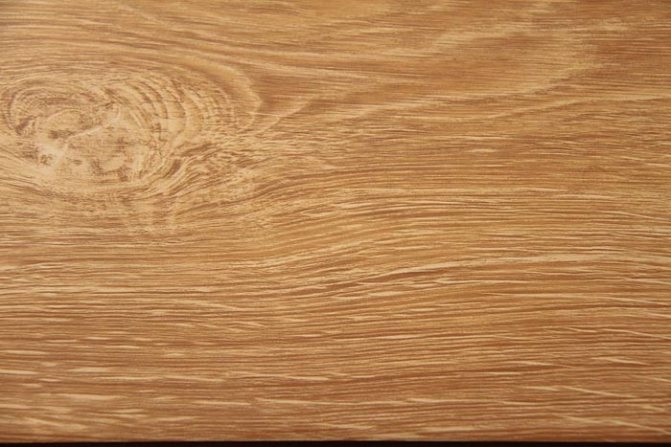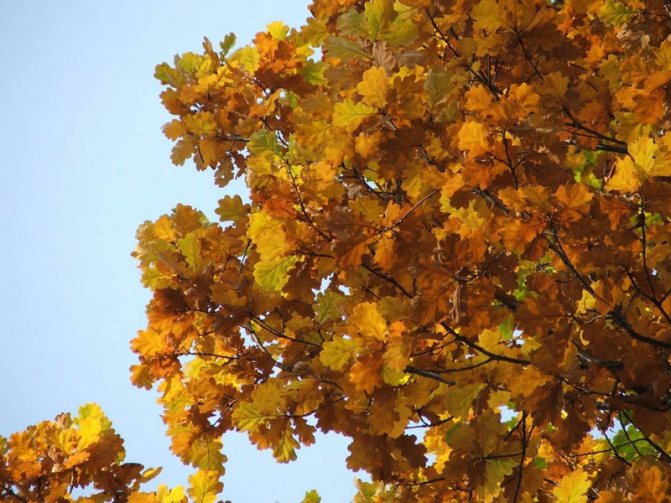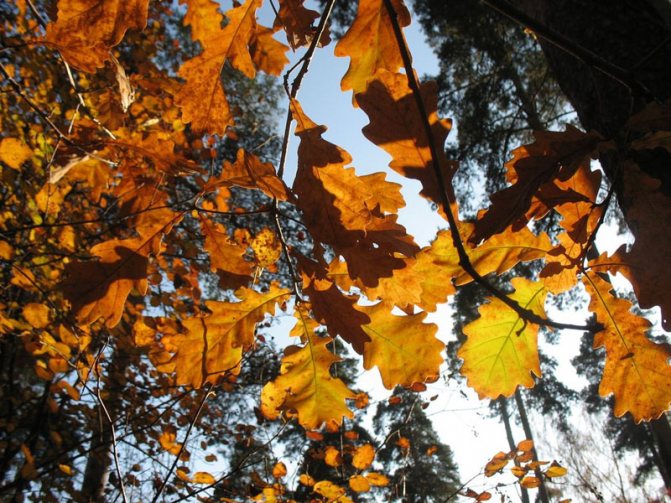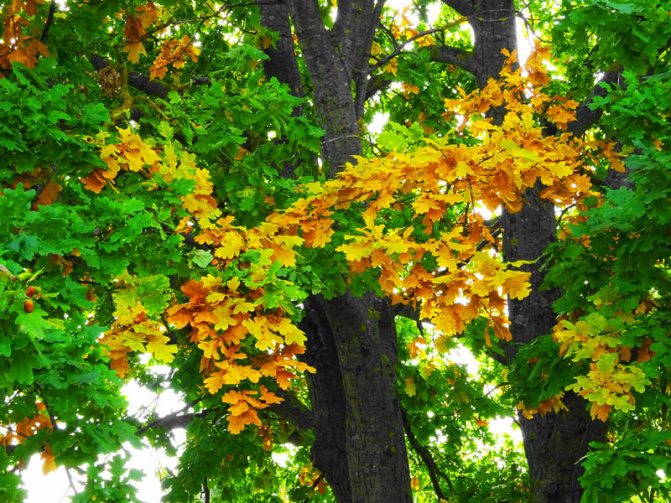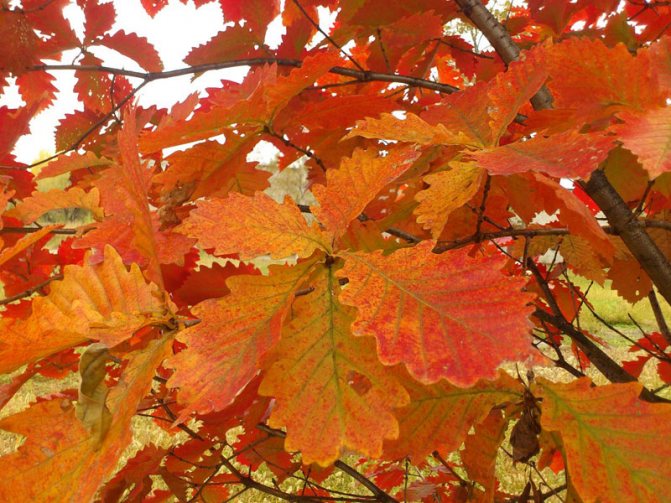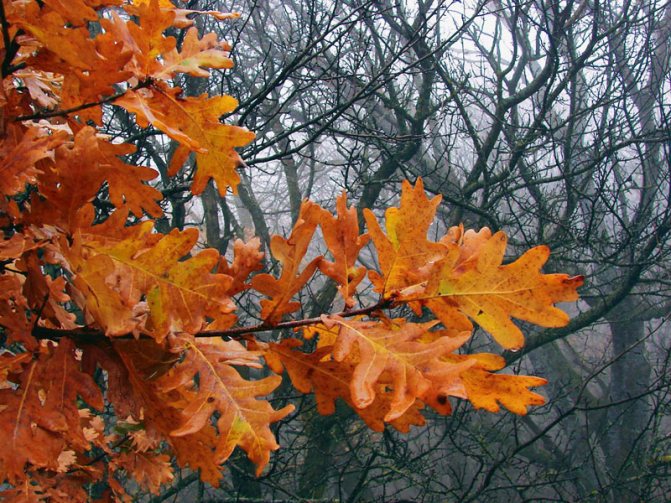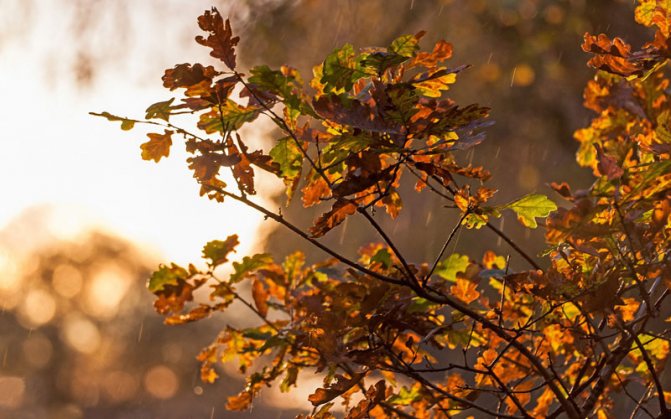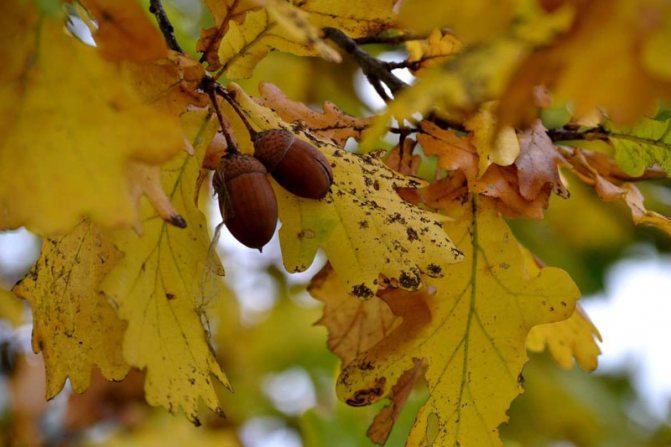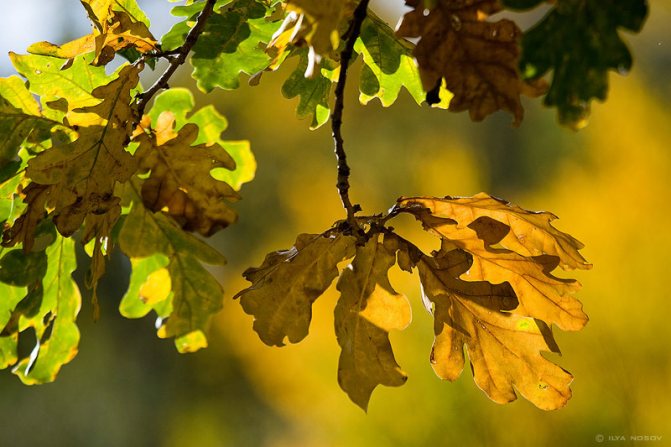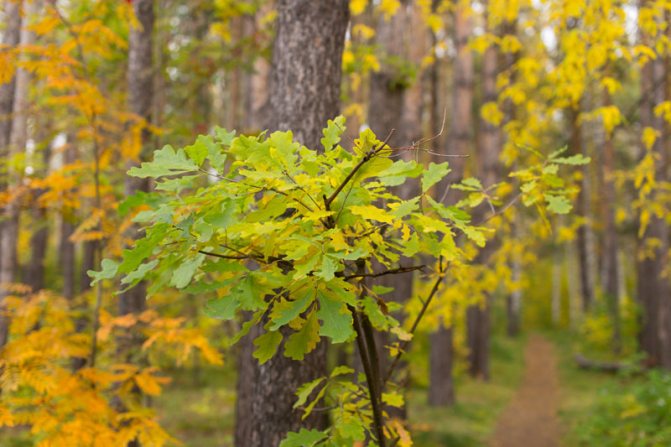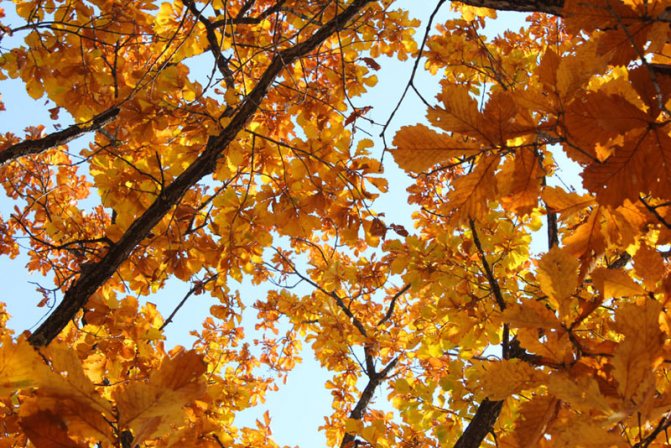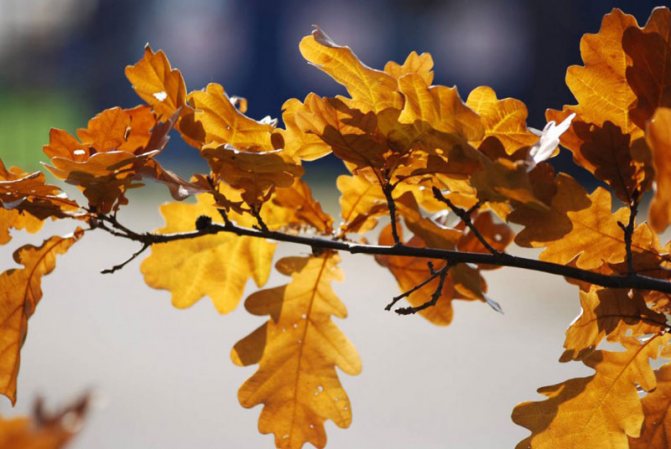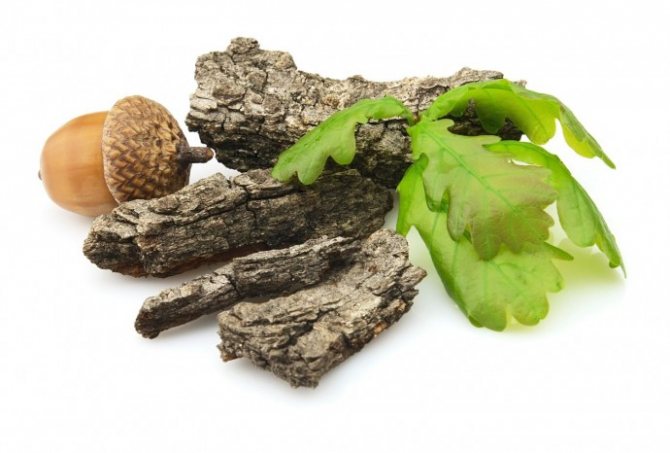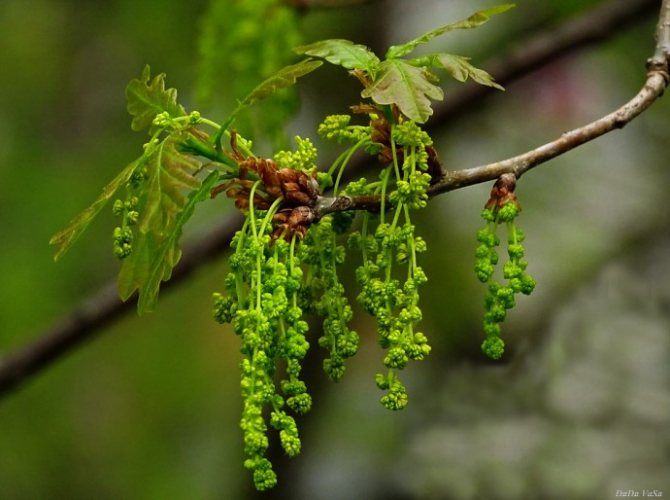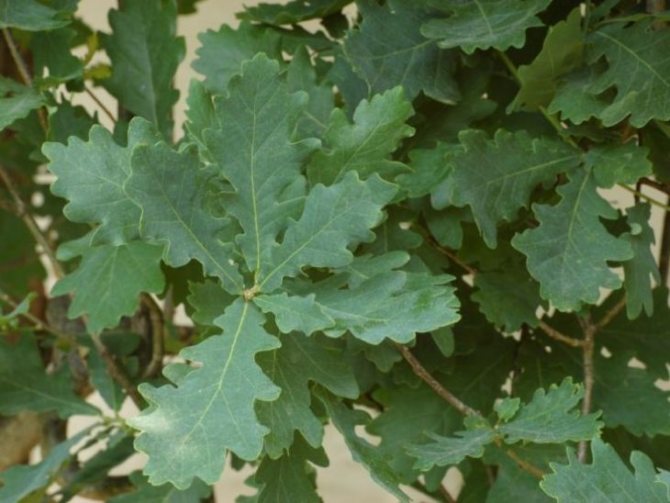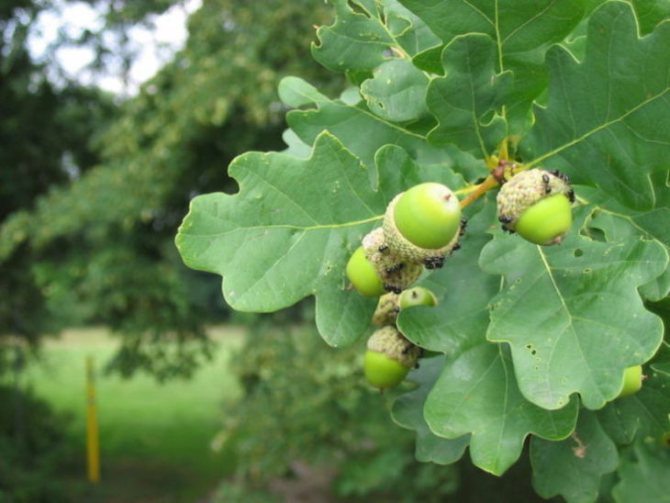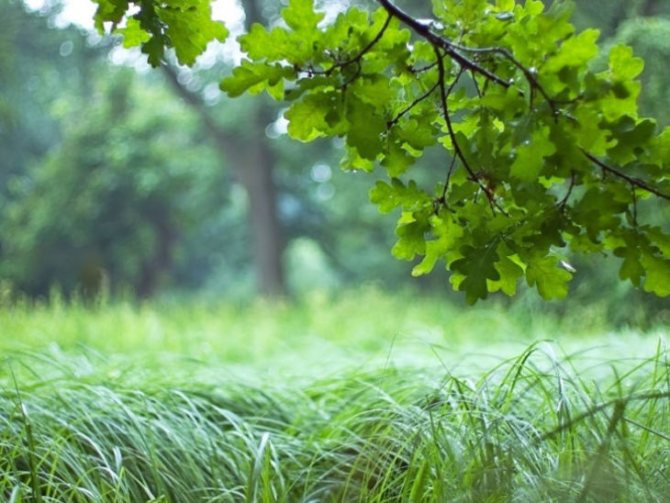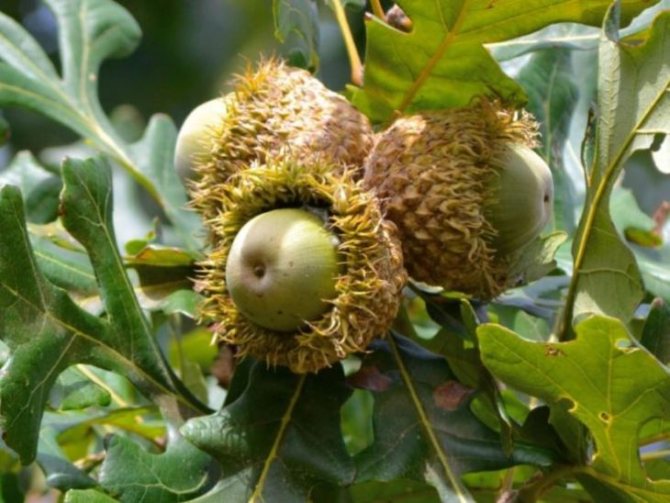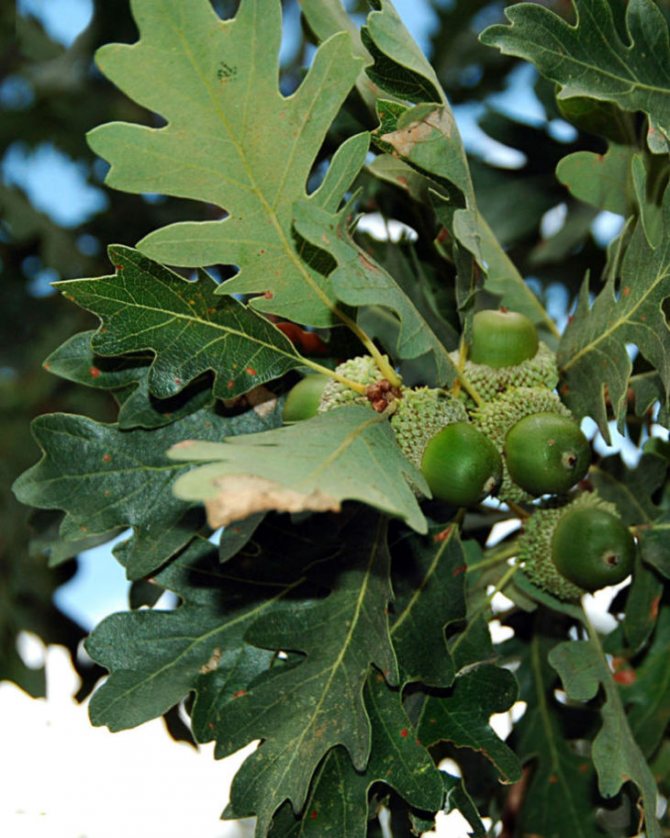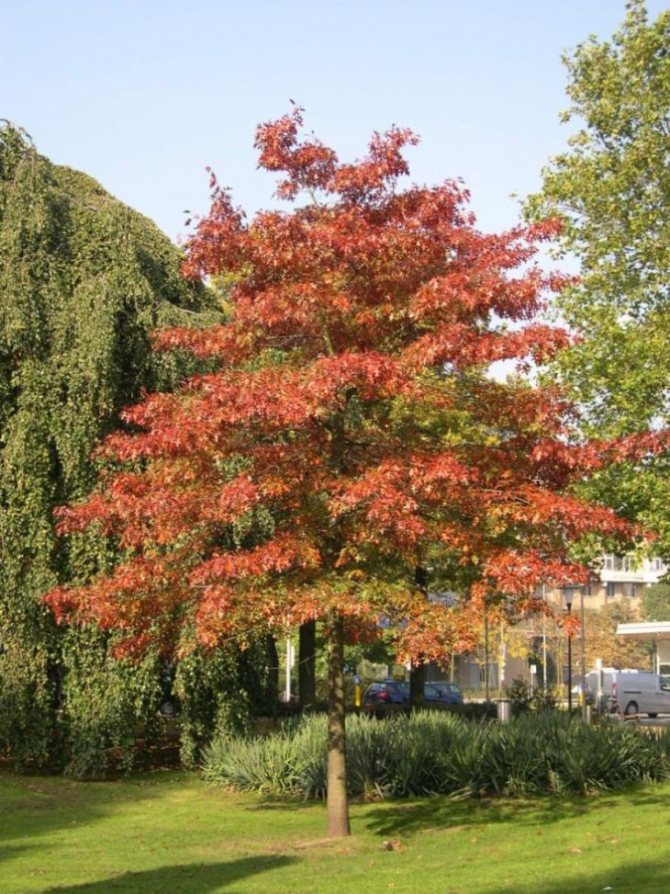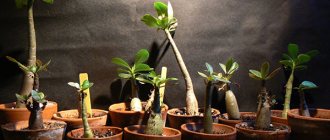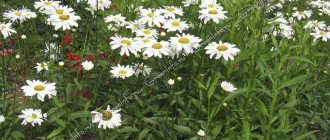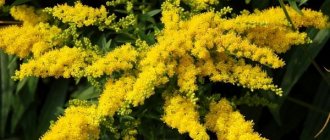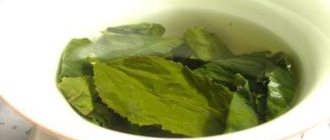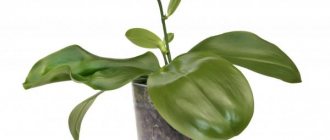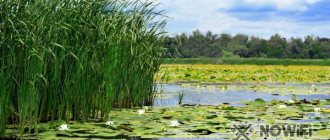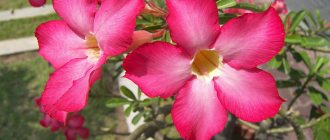Until recently, common oak or English oak (Quercus robur) was the most widespread crop from the coast of Brittany to the Ural Mountains.
This plant with a powerful trunk, a well-developed crown and a massive root system has taken root well in Western and Central Europe, the European part of Russia, and North America in Asia.
In relict groves, individual specimens reach a height of 50 meters, and the average life span of a tree in natural conditions ranges from 500 to 900 years.
Oak - botanical description
More than 450 species of oak are found in nature. Most often it is an ordinary or pedunculated oak. Growing conditions play an important role in the formation of the external appearance. In oak forests and natural forests, it is a tall plant with a long trunk and a pronounced crown. In such specimens, the trunk is cleared of branches and twigs to a considerable height.
Stand-alone trees, on the contrary, have a spreading crown, and branching begins literally at a height of 1-1.5 meters from the ground. Often the branches of the crown touch the ground.
Depending on the age of the plant, the bark has a big difference. In young trees, plants up to 40 years old are considered young, that is, before the beginning of the fruiting period, the bark has a smooth texture, light brown, brown and even olive in color. As it matures, the bark acquires a grayish tint and by the age of 60-70 it becomes dark brown or almost black.
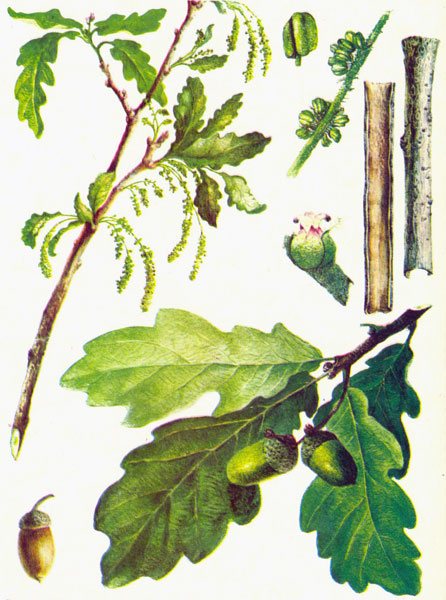
Photo: Leaves and fruits of oak (acorns) ordinary
Leaves, depending on the type, can have a different shape and color, but they have one thing in common - they have the next arrangement of plates, and at the ends of the branches are collected in bunches. The leaves are usually 10-12 cm long, but unlike other deciduous plants, they do not have a single standard.
On one plant, before the end of the flying around the foliage, leaves of both large size and very tiny - up to 3-5 cm in length can be observed. The leaves are elongated, many have an ovoid shape with a predominance of side plates of different lengths.
Leaves are asymmetrical due to unequal lateral lobes. The color of the foliage at the time of vegetation is herbaceous green, in the summer it is deeply saturated dark green, during the wilting period it can acquire a light brown, pale green or fiery red color like that of a red oak (Quercus rubra).


Photo: English oak leaves
The foliage usually opens late, in mid-late May. And the flowering of adult specimens begins early - in late April - early May. The flowers of the common oak are unisexual, nondescript and small in size.
Male monoecious flowers are collected in inflorescences of dark yellow color with a greenish tint. Fruits in the form of acorns ripen in early autumn, young plants have small acorns, but in middle-aged trees 60-150 years old, fruits can reach a length of 3.5 cm and weigh up to 10 grams.
Oak grows slowly compared to other deciduous species. The greatest growth is observed in the period 5-25 years. With cultural pruning, it is possible to forcing the trunk to a height of 10-12 meters and form the correct crown.
This tree is not demanding for light, but at the same time it actively fights for its place, suppressing other plants in its range.
A powerful root system allows you to grow on almost any soil composition.In this case, preference is given to more nutritious, humus-rich soils. This is an extremely hardy tree - it can tolerate dry periods of up to 3 seasons in a row without great losses, when the amount of precipitation can be 10 times lower than normal, and short-term periods of flooding - up to 20 days.
Reproduction is carried out in vivo with acorns. Seed germination is high; when grown under artificial conditions, germination can reach 85-90% of the seed.
Climate and soil
Oak prefers a temperate climate.
Sometimes the mighty tree grows in the tropics, choosing high-altitude areas and avoiding too high temperatures.


Soil fertility is important for oak
from which it absorbs essential nutrients by a well-developed root system. Despite the fact that the oak grows in conditions of moderate humidity, some species survive in the swamps surrounding forests and arid regions.
Types of oak for decorative cultivation
Of the known 450 species, about 20 are used for ornamental cultivation. There are two main directions in cultivation - cultivation as an ornamental crop in the open field and the formation of dwarf plants for display in indoor conditions.
Petiolate
This tree has several names - English oak, summer oak or more often referred to as pedunculate or common oak, this is the most common species on the planet. The main distribution area is the European continent.
The plant is tall with a properly folded crown and a massive trunk. The tree takes root equally well both in a mixed forest and independent placement in open areas.
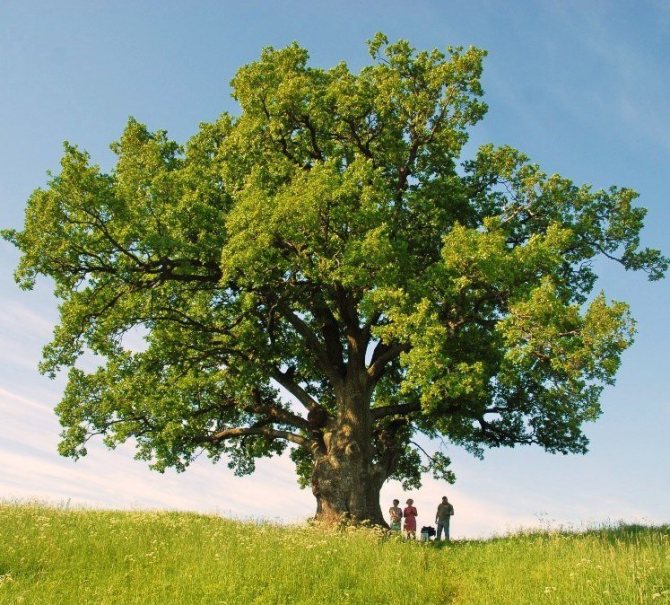

It perfectly tolerates dry periods and rainy times, it is even able to survive in conditions of temporary flooding of the site. The period of active growth is observed in natural conditions up to 20 years, with artificial decorative cultivation, the growth period can be extended to 25-30 years.
Leaves of various sizes with rounded lateral petals, on the reverse side with a pronounced relief pattern.
The tree is propagated by acorns. Germination rate in the first year reaches 40-50% of the seed in natural conditions. By the end of the first year, 10-15% of the plants survive.
Acorns are very sensitive to drying out, the second most dangerous factor is frost. Under natural conditions, wintering takes place on a damp foliage litter and under a large layer of snow.
Considering that foliage can fall off during warm autumn and mild winter until February next year, a mixture of sleet and a large layer of foliage creates all the conditions for preserving acorns.
When grown at home or indoors, it is necessary to monitor the constant moisture content of the soil. Before planting in open ground, it is imperative to harden the plant.
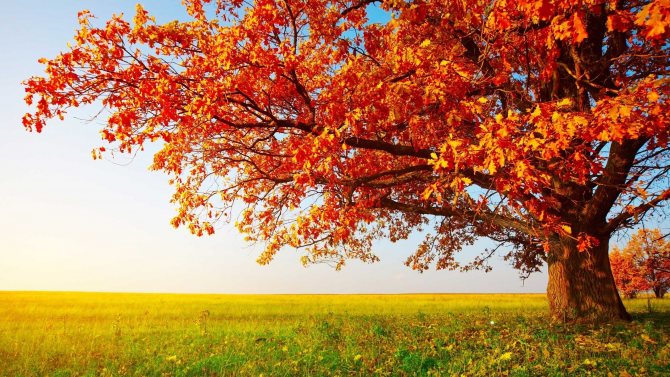

Photo: Oak in autumn
Mongolian
Mongolian oak (Quercus mongolica Fisch) is the most widespread for the Far East region. This broad-leaved tree is found almost everywhere in the relatively mild conditions of the Far East.
His crown, both in a forest and in a separate location, reaches a height of 25-28 meters. The trunk diameter at the base can reach 1 meter. He received distribution not only on the continental territory in Primorye, but also on Sakhalin and the islands of the Kuril ridge.
On the mainland, it is mainly found in the form of trees, but on the islands it often grows as a shrub with a short crown. Mostly widespread are trees with well-built slender trunks and wide domed crowns.
The trunk cover of young trees is smooth, almost glossy. For middle-aged trees, it is brown in color with a characteristic texture covered with cracks.
Leaves are large, oblong-ovoid. The length of the leaf is usually 8-15, sometimes up to 17 cm. The width reaches 5-8 cm. The shape of the leaf is obversely oval with an asymmetric arrangement of the extreme lobes. Leaves are dense, tough.


Photo: Mongolian oak leaves
Male flowers, like all oaks, look like earrings, female flowers are located in the depth of the inflorescence, small, invisible. Pollination of female flowers is carried out with the help of the wind.
Fruits are oblong, ovoid, 1.5 - 2.0 cm long. One rosette can contain from 2 to 5 acorns, rosettes are located at the ends of young branches. Acorns have a glossy surface with a characteristic shine, the color depends on the quality of the soil, in most cases it is light brown or dark yellow.
Mongolian oak is an unpretentious tree, but seed germination under natural conditions is relatively small - up to 30%. When decorating the plots, a spherical or spherical crown of medium height is formed.
Rocky
These trees of the beech family have several names, and in the literature they are referred to as rock oak (Quercus petraea Liebl) and as Welsh. They spread in Europe and Asia, from the British Isles to the Caspian coast. They are among the most valuable exhibits in arboretums and reserves in both Western and Eastern Europe.
The plant is light-requiring, it gets along well both in monocultural plantings and in mixed forests with coniferous and deciduous tree species.
The height of mature trees is up to 27-30 meters, the most productive growth phase is from 5 to 20 years. The crown shape is correct, ovoid in trees up to 40 years old; later, with the beginning of the growth of the branches of a high crown, it takes on a hipped or domed shape.
In young plants, before the onset of fruiting, the bark has a smooth texture with a characteristic olive tint. With the onset of maturity, it coarsens, shallow cracks appear, while they are not as pronounced as in the ordinary one.
Leaves are of medium length up to 12 cm, of a standard appearance with an odd number of lateral planes. Leaves of medium hardness, firmly attached to the branches. Oak lives up to 600-900 years. Fruiting begins at the age of 30-35.
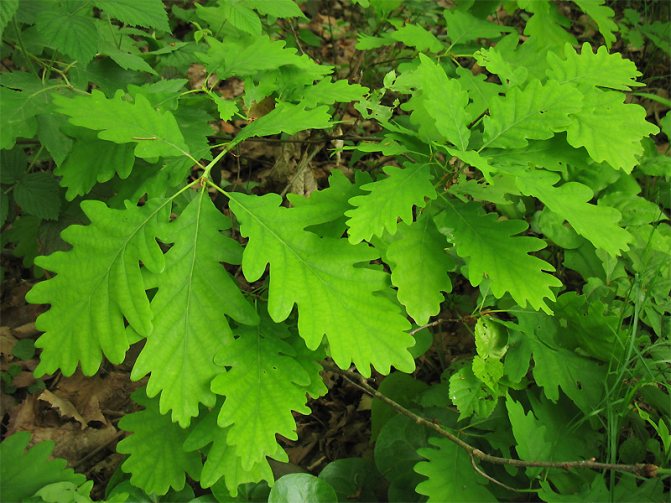

Photo: Cliff oak leaves
Prefers southern regions with a milder climate. It is unpretentious to soils, it takes root well on stony and rocky soils. It grows well both in the wild and in cultivated breeding. Thanks to its powerful root system, it easily adapts to all types of soil and soil.
What does an oak look like in autumn
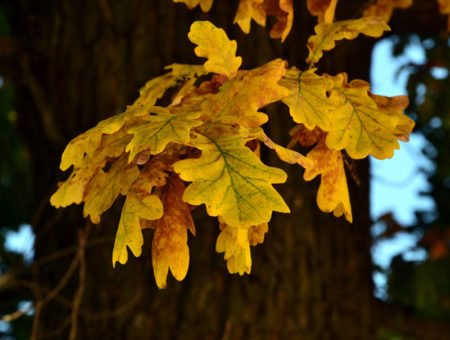

The oak, which can be found in the forest in autumn, does not lose its amazing beauty. It changes the color of the foliage from green to bright yellow. In the first autumn months, the leaves are amber yellow. Closer to winter, they dry up and turn brown.
It is interesting! Among the long-lived oak trees there are specimens over 1000 years old.
Many forest trees shed their bright outfits by October and remain completely naked. The autumn oak is in no hurry to part with the foliage. Even if its leaf becomes dry and brown, it clings tightly to the branches, remaining on them until the next spring.
If a tree grows in the thicket of the forest, it is cramped among other deciduous plants. Its trunk begins to stretch and become thinner. But if he grows in a spacious clearing, he becomes a mighty handsome man. Its trunk is thick, so the tree looks squat and stocky. Its branches, spreading out in different directions, form a lush crown, decorated with carved foliage.
When a person meets such an oak tree in the fall, the desire to describe it and share the experience with friends may awaken in his soul. Many people, amazed by the beauty of this tree, post beautiful photos on the Internet: sometimes ordinary words are not enough.
Deorevo grows strictly vertically, and its roots go deep into the soil, keeping the oak upright. It endures the attacks of caterpillars and other harmful insects.Even if they completely destroy its foliage, the mighty hero will still survive and grow a new lush crown.
If the tree is cut down, after a while new leaves will appear on the stump. They will quickly turn into shoots that will reach out to the sun. The strongest branch in the future will be the trunk of a new oak tree.
Growing oak
The main method of growing oak is acorn germination. To obtain decorative trees, the grafting method of propagation is used. For the formation of new plantings, two-year-old seedlings, germinated in a natural way, can be used.
How to grow an oak from an acorn?
For sowing, seed is taken in early to mid-September. To form an array of plantings, it is recommended to plant immediately, preventing the acorns from drying out and to sow directly into the ground.
For spring planting, seed is prepared with a shelter for wintering. To do this, acorns are instilled into the ground to a depth of 20-25 cm. Under the acorns, a substrate of 3-4 cm is made of fallen leaves. From above, acorns are also covered with foliage with a layer of 3-4 cm. Then the soil is filled up, and from above the place of conservation is covered with spruce branches and watered with water.
You can germinate an acorn at home using only fresh material. Acorns that have been stored for several years or kept at room temperature are not suitable for planting.
It is better to store non-sprouted acorns in a basement in a container with wet sand or in a refrigerator at a temperature of + 3-4 ° C. It is recommended to plant an oak acorn at home in a pot or container in early - mid-April. Germination is carried out in moderately moist soil. After the emergence of seedlings, watering is alternated with loosening the soil.
There should be enough soil in the container, since the plant's root system is very powerful and requires a lot of soil. Hardening of seedlings begins after the appearance of the second leaf. Landing in open ground is carried out at an air temperature of 10-15 degrees. Watering is carried out 2-3 times a week.
Planting a seedling
Seedlings grown in the open field are planted in a permanent place at the age of two or three years. An early transplant is not recommended as the plants have not developed a normal root system and are therefore very vulnerable. Seedlings over 4 years old have a deep root system and transplanting will be very traumatic for already strong roots.
Planting is carried out in a prepared hole 30-40 cm deep with compost or other organic fertilizer laid on the bottom.
After the rhizome of the seedling has been sprinkled with earth, watering is done with 10-12 liters of water. Re-watering is done in 5-7 days. After the appearance of new shoots on the seedling, the time between waterings is increased, and mineral fertilizers are added to the water.
Oak care
The technology of care does not differ from the methods of caring for fruit trees.
The list of works includes:
- inspection of the tree after the winter period;
- spring feeding during the active growing season;
- periodic watering of trees 1-2 times a month in summer;
- in the fall it is recommended to prune from 4-5 years of age, this will allow the formation of the crown to begin;
- in the fall, coloring of the trunk is also done to protect against sunburn, especially for young plants of the southern range, in which the bark has not yet acquired a characteristic texture;
- during the growing season and summer months, it is recommended to do treatment to protect the plant from pests and diseases.
Spread
Oak is common in the Northern Hemisphere
, which is explained by comfortable weather conditions.


The powerful tree was respected in European countries, it was considered sacred. Meetings and ceremonies were held under the oak trees.
However, most of the oak forests have been razed to the ground. People needed areas for arable land and the expansion of villages and cities. Now oaks occupy no more than 5 percent of the entire forest belt in Europe.
Diseases and pests
May beetles are the most dangerous enemy for young leaves and shoots. True, it must be said that this is only one of more than 70 species of insects that mercilessly eat the leaves and young twigs of the tree. There is only one method of dealing with them - spraying with fungicides and bioprotective agents.
The second most common foliar lesion is gall midge - small green balls on the underside of leaves varying in size from a large pea to the size of a small cherry. Inside these balls are the larvae of the gall midge, a leaf-eating insect. Gall midges appear in summer, therefore, from mid-June it is recommended to do preventive treatment of foliage with a solution of Topaz fungicide or Bordeaux mixture.
Powdery mildew infects foliage and makes the plant look unsightly. Leaves affected by powdery mildew are recommended to be treated with Topaz or Bordeaux mixture. In autumn, after the end of the leaf fall, it is recommended to collect and burn all the foliage, this will reduce the risk of diseases in the future.
Useful composition of oak wood and fruits
Wood is durable. After drying, its qualities do not change. With proper care, it serves for about a century, does not dry out, does not crack.
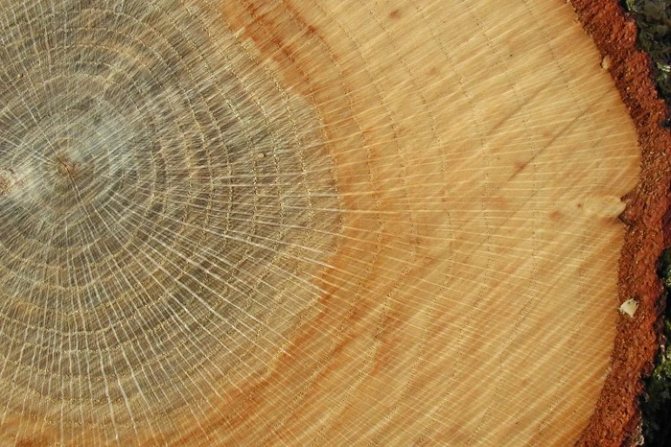

When it is in water for a long time, it does not deteriorate, does not rot, but turns black. Such wood is known as moraine. It is harder, but soaking results in increased brittleness.


The fruits are famous for their high content of tannins, beta-carotene. In addition, they contain essential oils and starch.
The fruit of the oak tree - acorn (with photo)
Little must be said about acorns. It should be noted first of all that these are not seeds, but fruits (since each is formed from the pistil of a flower). But acorns are like the fruits of the oak tree, peculiar: their entire content consists of only one large seed.
Some other features of acorns are also interesting. Let's compare them with the seeds of familiar plants, for example, peas, beans. The mature seeds of these plants are completely dry. They keep excellently in warm and cold weather. But acorns are not like that. They are relatively juicy and very moody. First of all, they do not tolerate drying at all. As soon as they lose even a small part of the water, they die. They are also sensitive to frost.
Finally, they rot very easily. Therefore, it is rather difficult to store the fruit of the oak tree for a long time. It is especially difficult to keep them alive during the winter, from autumn to spring. This problem sometimes arises for forestry workers.
Indeed, how to protect acorns in winter from several dangers at once - from frost, drying out and decay? There are many ways to save them. One of the most effective is to put the collected acorns in a basket in the fall, close it and lower it to the bottom of the river until spring (water, of course, must be running so that the acorns do not "suffocate").
The oak seed is characterized by the fact that almost all of its contents make up the rudiment of the future plant - the embryo. But the embryo here is unusual: its cotyledons are exorbitantly developed powerfully. There is a lot of starch in them. This is a supply of food for a young oak tree that will emerge from an acorn.
Look at the acorns of the oak in the photo, which shows all the features of this seed, intended for the process of culture propagation:
Gauls on oak leaves
In autumn, on oak leaves, you can often see yellowish or yellow-pink balls the size of a small cherry. Such balls are called galls. Galls on oak leaves are a painful overgrowth of leaf tissue. The reason for their appearance is the gall midge insect, similar to a very small fly. At the beginning of summer, the gall midge pierces the skin of the leaf with a thin, sharp ovipositor and lays an egg in the leaf pulp. The plant reacts to this foreign body with a strong proliferation of tissues, and after a while a ball-gall grows on the leaf. If you break such a ball in late autumn, in the middle of it you can find a small white worm - a gall midge larva or an adult insect.In some years, oak leaves are literally dotted with galls - there are several of them on each leaf.
Gauls on oak are sometimes called "ink nuts". This name is not accidental. They were once used to make black ink. To get ink, you need to prepare a decoction of nuts and add a solution of ferrous sulfate to it. Merging two slightly colored liquids, we get a liquid that is completely black. This unusual phenomenon can be easily explained. Halle contains many tannins, which have the ability to combine with iron salts to give a thick black color.
Varieties
The biological reference lists several species of these plant giants. Among them are common oak, pedunculate, rocky oak. All representatives of the genus belong to the Beech family. Have you ever seen a deciduous tree that keeps leaves all year round? So, among the late oaks, this is a common phenomenon. Early forms bloom in early April and shed their foliage for the winter. And the late ones wake up closer to May, so young trees can turn green all year round. In nature, separately growing trees are more common, less often oak forests.
Interesting facts about oak and its fruits
Oaks do not produce acorns until they are 20 years old. After that, from every ten thousandth fruit that falls to the ground, a new tree grows.


Acorns are actually considered nuts. It is thanks to them that wild boars survive, which eat the fruits and thereby accumulate fat.
The cost of bog oak lying in water exceeds 300 thousand per cubic meter. This is the price of tree trunks. The cost of the boards increases several times.
Oak is a powerful tree, the fruits and wood of which have unique properties, their value can hardly be overestimated in construction, industry, medicine. In Russia, it is widespread, even found on the coats of arms of cities and provinces. In total, there are more than 600 plant species in the world.
Nuts


The fruits of the pedunculate oak are glabrous, placed on a long stalk. Its size is three to eight centimeters. The acorns are brownish brown. Their length is one and a half to three and a half centimeters, and their diameter is one to two centimeters. The nut is placed in a saucer called a plus. Fruits ripen by September-October.
Acorns are characterized by good germination. They are spread by birds, especially jays. Up to ten years, seedlings grow slowly. Then the growth accelerates to thirty-five centimeters per year, sometimes more.
Caution! Side effects
- General recommendations are the moderate use of medicines according to folk recipes.
- Doctors categorically forbid giving decoctions and powders to children.
- Too frequent rinsing of the mouth with infusion from the bark can lead to poisoning, vomiting. Loss of smell can threaten those who use drugs for too long.
- It is not recommended to try natural medicines for those suffering from constipation and hemorrhoids.


Use in construction
Due to the fact that wood does not rot in water, structures are built from it, submerged to the bottom of seas and rivers, and ships are created.


The older the tree, the more rings on its trunk. Such an oak, distinguished by its considerable age, is especially valuable in structure. Souvenirs are also made from softer, which means young trees. Strength increases over time.
Building materials are made from oak wood due to their low susceptibility to burning. It is considered to be fire resistant.
There is a version that the oak owes its name to the ancient Greek word, which translates as "build". After all, the quality of wood was appreciated many centuries ago.
Leaf pictures
At the mention of the autumn park, many people have a picture from a botany textbook depicting an oak leaf before their eyes. There are those who collect herbariums and even start special albums. But you can also sketch in your sketchbook.
If desired, in the fall, everyone can try themselves in the role of an artist.You need to go to the park, collect oak leaves there and create a whole collage.
In order to make it easier to depict a sheet, you can simply circle it on paper with a pencil, like a template. And then everything depends solely on imagination and artistic skills.
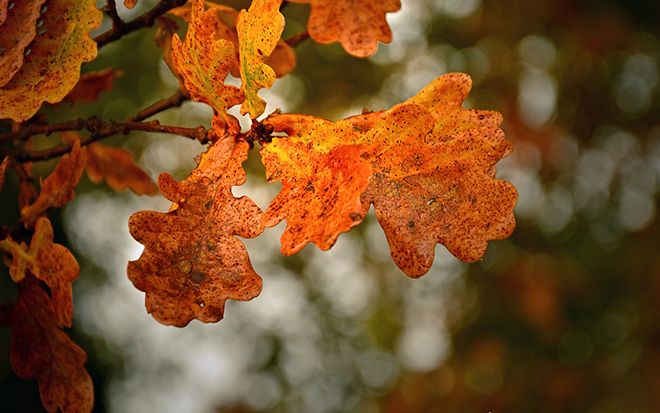

For example, you can color a drawing with watercolors, pencils, or felt-tip pens. And you can take any shades - you can find a lot of photos and hand-drawn images that will prompt the palette option.
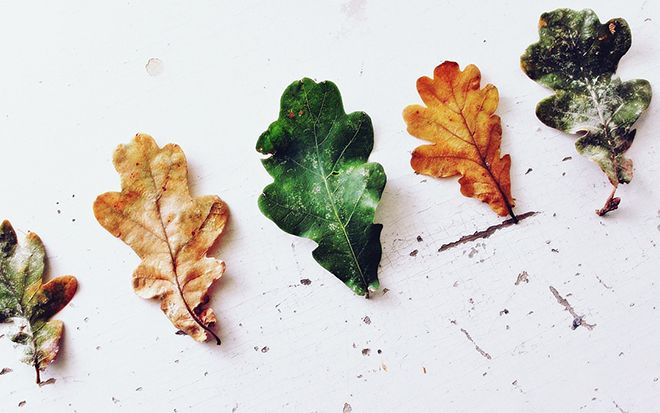

If the color of summer leaves varies from light to dark green, then in autumn brown, and brownish, and yellow, and bright red shades are possible. At the same time, the veins always appear darker, and sometimes they are also contrasting. A little patience and the picture will be ready.
Recommended species and varieties
Q. borealis
The crown is spherical. Leaves fall only in the harshest winters. Their plates are obovate, with rounded lobes, 12.5 cm long. The bark cracks with age and becomes brownish-gray. A heat-loving species that can be cultivated in Russia in the south of the Krasnodar Territory. Plant height and diameter - 8x5 m (20 years). The maximum height is 30 m.
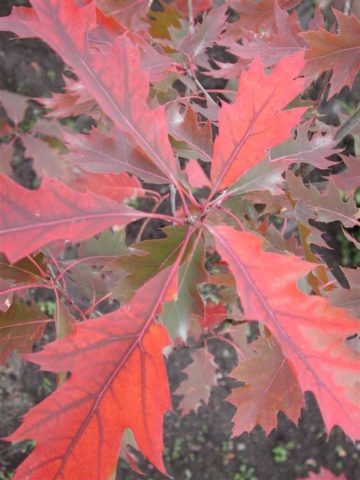

Heat-loving species
Q. castaneifolia "Greenspire" (D. chestnut)
The crown is narrow. Leaves falling for the winter are glossy, oblong or oval, with coarse triangular teeth along the edge, about 18 cm long. The height and diameter of the plant is 14x5 m (20 years). The maximum height is 30 m.
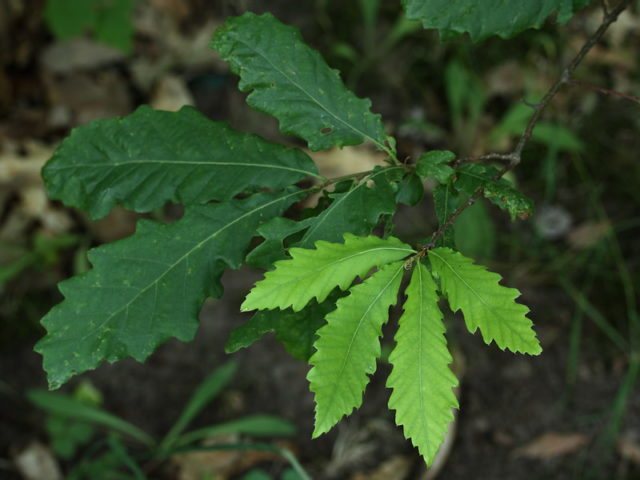

Glossy leaves
Q. coccinea (D. scarlet)
The dark green leaves turn scarlet in autumn and fall off. Their plate is 15 cm long, with pointed lobes. The silvery-gray-brown bark remains smooth for many years. Homeland - the east of the United States and the south-east. Canada. Acorns are rare in Europe. Stable up to -30 ° C. The height and diameter of the plant is 10x8 m (20 years). The maximum height is 25 m.
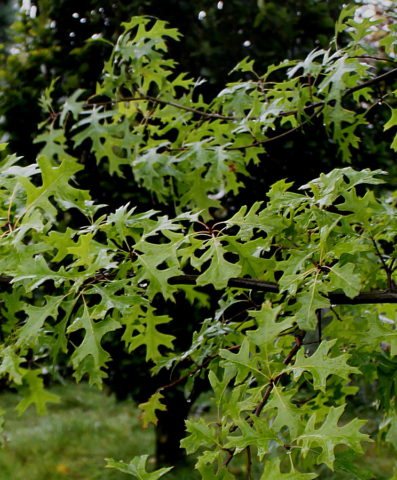

Dark green leaves
"Splendens"
In this cultivar, the autumn color of the leaves is especially attractive.
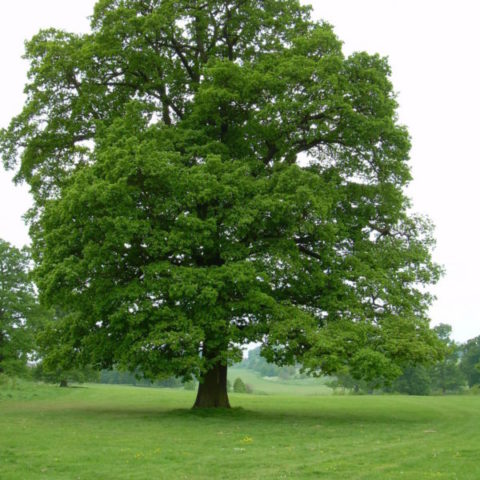

"Splendens"
Q.frainetto (D. Hungarian)
The leaves are deciduous, leathery, multi-lobed, up to 18 cm long. Their plates are narrow at the base and widest at the apex. Homeland - V. Europe. Withstands up to -20 ° С, and therefore it is recommended for the southern regions of Russia. Plant height and diameter - 8x5 m (20 years). The maximum height is 30 m.
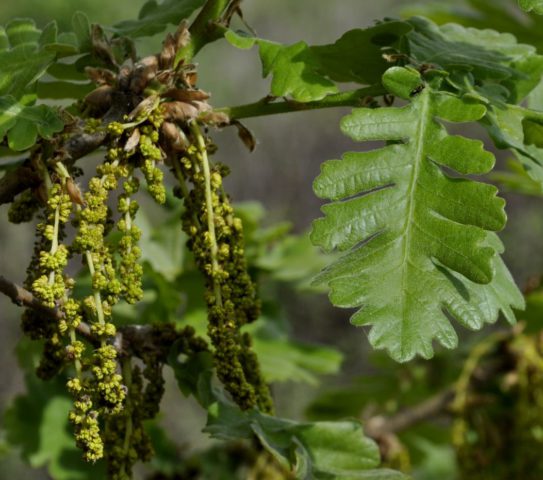

Falling leaves, leathery
Q. ilex (D. stone)
An evergreen tree with a globular crown and dark gray cracked bark. Leaves up to 6 cm long, leathery, glossy, dark green above and gray below, sometimes with rare sharp teeth. After a particularly hot summer, small and green but viable acorns are formed. Despite the relative cold resistance, this oak thrives best in the mild coastal climate. Homeland - Chile. This thermophilic subtropical species can only be grown on the Black Sea coast. The height and diameter of the plant is 6x5 m (20 years). The maximum height is 25 m.
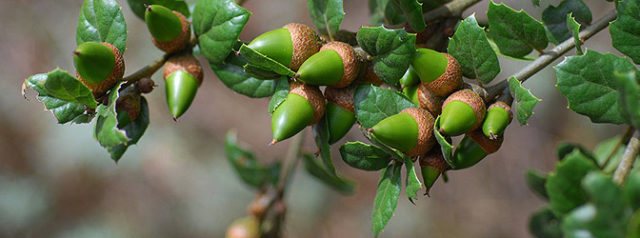

Evergreen tree with a globular crown
Q. palustris (D. marsh)
Deciduous tree with a dense crown and silvery-gray bark. Leaves up to 12.5 cm long with deeply carved toothed lobes, glossy green. After a hot summer, they turn reddish-brown. Short shoots on young trees are angular, like hairpins. The species tolerates moist soil well. Homeland - S. America. It is considered quite frost-resistant (up to -29 ° C). The height and diameter of the plant is 9x5 m (20 years). The maximum height is 30 m.
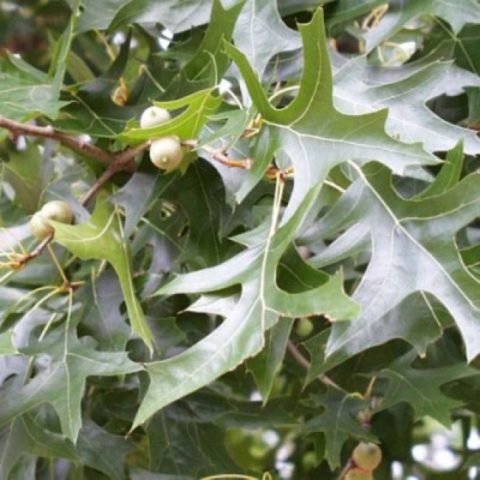

Deciduous tree
Q. pedunculata
A long-lasting Western European deciduous tree with a preference for a seaside climate. The color of the bark varies from gray to black-brown. Leaves up to 17 cm long, broadly oval, with rounded lobes. Plugs are sessile, without peduncles. Winter hardiness varies depending on the form from -20 ° C to -30 ° C. Plant height and diameter - 6x4 m (20 years). The maximum height is 35 m.


Long-lasting deciduous tree
Q. phellos (synonym of Q. pumila) (D. willow, D. dwarf)
Semi-deciduous tree with a spherical crown and elliptical glossy leaves up to 15 cm long, which will turn yellow and orange in autumn. Requires protection from wind and fertile moist soil. Acorns are rare. Homeland - the southeast of the United States. Comparatively thermophilic: it can withstand frosts only down to -23 ° С. Plant height and diameter - 4x3 m (20 years). Maximum height -8 m.


Semi-leafy tree
Q. robur (syn. Q. pedunculata) (D. ordinary, D. petiolate)
A long-lasting deciduous European tree with a spreading crown. The leaves are green, obovate, with rounded blades, up to 14 cm long. One of the most winter-hardy species for central Russia. In some regions, it suffers from spring frosts. Plant height and diameter - 6x4 m (20 years). The maximum height is 32 m.
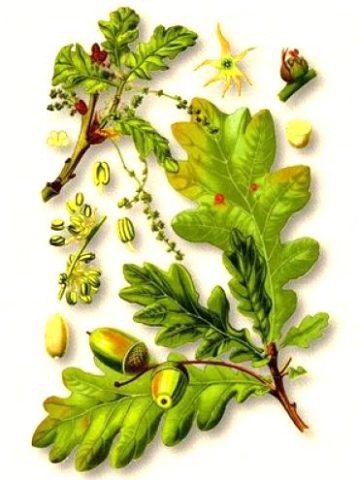

Tree with a spreading crown
"Concordia"
Small, slowly growing tree with a spherical crown and golden leaves sticking up.
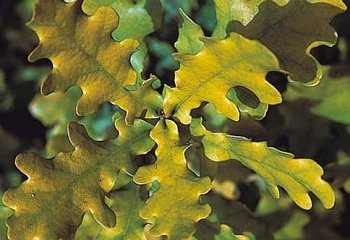

Small, slow growing tree
Q. rubra (syn. Q. borealis) (D. red, D. northern)
Deciduous tree with a broad globular crown. Leaves up to 20 cm long, with large triangular teeth and lobes. At first, pale green, they become dull red, brown or orange-yellow in the fall. The bark is smooth, silvery gray or pale brown. Germinating acorns are rare. Homeland - S. America. In the middle lane, it does not grow well everywhere. It tolerates winter temperatures down to -35 ° C, but is severely damaged by spring frosts. Plant height and diameter - 10x6 m (20 years). The maximum height is 30 m.


Leaves with large triangular teeth
Q. sessiliflora
Semi-deciduous tree with a spherical crown. The bark quickly becomes cracked and dark brown. Leaves with finely cut lobes, dark green, up to 8 cm long. They often do not fall off all winter. Frost resistance - up to -23 ° С. Plant height and diameter - 8x4 m (20 years). The maximum height is 18 m.
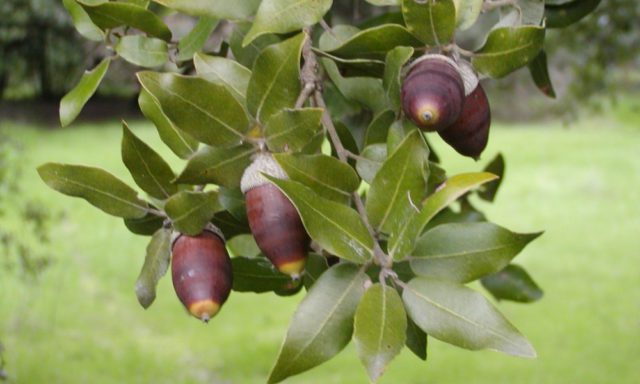

Leaves with finely cut lobes
Beneficial features
It is not only oak bark that has beneficial properties. For example, acorns are used to treat intestinal disorders, hernias and skin diseases.
Oak foliage smells good and is an obstacle to the development of rot. Fragrant bath brooms are made from tree branches. Tubs intended for pickles are laid out with leaves. The workpieces do not sour and become especially tasty.
You can also make children's crafts from acorns. Acorns look very nice: they have a round shape and a pleasant glossy shine.
Where is wood used
Hardness and long service life allows the use of wood in shipbuilding, in the mining industry. She is it has a high density, which is important for construction and finishing works.


Wood is used to create furniture, toys, parquet. It can be tinted to give a new shade. But it has its own rich palette, it is found in both light beige and dark brown shades.
The beneficial composition of the fruits made them one of the ingredients for the preparation of medicines.
Industrial applications
Oak is used in the furniture industry. High strength and durability make it almost indispensable in this area.
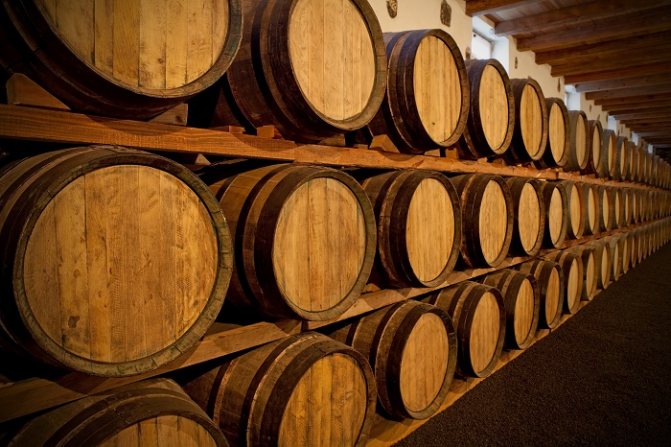

In the wine industry, it is used to make barrels in which wine is languishing. Corks are also made from them, thanks to which sparkling drinks do not fizzle out.
The acorns of some oak species are used in the food industry. The fruits of trees growing in Italy have a sweet taste. Acorns, common in Russia, are used to make a powder that serves as a substitute for coffee.
Medical use
The beneficial properties of the fruit of the tree are used in medicine:
- tannins kill bacteria and help improve stomach function;
- Beta-carotene helps with heart disease and removes toxins that pollute the body.


Oak bark relieves inflammation. A decoction is prepared from it, which is useful to drink for diseases of the throat and mucous membranes, including the stomach. The bark is harvested in spring from young oak trees. Then they dry it for several days until it becomes brittle.
The story about the beneficial properties does not end there. The leaves have a calming effect and help get rid of worms. An infusion of them will cure frostbite and eliminate burns.

